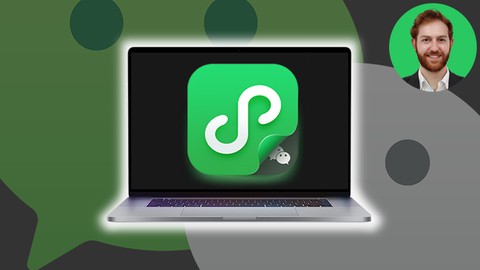
WeChat Mini Program – Everything you need to know
WeChat Mini Program – Everything you need to know, available at $74.99, has an average rating of 4.5, with 76 lectures, based on 28 reviews, and has 126 subscribers.
You will learn about How to make a fully functioning and responsive Mini Program Use Wechat's built in life-cycle functions for a more powerful Mini Program How to use data binding to create a responsive app based on events triggered by the user Installing and using npm modules in the front end Creating and connecting a backend and database for GET and POST requests to our program Understand the file structure of a Mini Program and its framework How to use WeChat's default components and icons for a more professional looking Mini Program How to install Wechat's Devtools and change its settings Debugging the Mini Program on different screen sizes and how to perform mobile debugging by testing on your phone Advice and guide to applying for an official account which will let you publish your own Mini Program This course is ideal for individuals who are People interested in learning about WeChat Mini Programs and developing their own applications or People who want to learn a powerful new skill for their portfolio or work, and to improve their mobile development knowledge It is particularly useful for People interested in learning about WeChat Mini Programs and developing their own applications or People who want to learn a powerful new skill for their portfolio or work, and to improve their mobile development knowledge.
Enroll now: WeChat Mini Program – Everything you need to know
Summary
Title: WeChat Mini Program – Everything you need to know
Price: $74.99
Average Rating: 4.5
Number of Lectures: 76
Number of Published Lectures: 76
Number of Curriculum Items: 76
Number of Published Curriculum Objects: 76
Original Price: $24.99
Quality Status: approved
Status: Live
What You Will Learn
- How to make a fully functioning and responsive Mini Program
- Use Wechat's built in life-cycle functions for a more powerful Mini Program
- How to use data binding to create a responsive app based on events triggered by the user
- Installing and using npm modules in the front end
- Creating and connecting a backend and database for GET and POST requests to our program
- Understand the file structure of a Mini Program and its framework
- How to use WeChat's default components and icons for a more professional looking Mini Program
- How to install Wechat's Devtools and change its settings
- Debugging the Mini Program on different screen sizes and how to perform mobile debugging by testing on your phone
- Advice and guide to applying for an official account which will let you publish your own Mini Program
Who Should Attend
- People interested in learning about WeChat Mini Programs and developing their own applications
- People who want to learn a powerful new skill for their portfolio or work, and to improve their mobile development knowledge
Target Audiences
- People interested in learning about WeChat Mini Programs and developing their own applications
- People who want to learn a powerful new skill for their portfolio or work, and to improve their mobile development knowledge
WeChat Mini Programs are powerful tools for companies to use to reach their audience, and developers in China and abroadwill be needed to meet this demand.
To help get you started on your Mini Program journey I’ve created this course to save you time spent researching, and instead get you on your way to publishing your very own Mini Program.
This course will take you from start to finish in creating your first Mini Program. We will not only cover the coding and testing aspects of development, but will also learn the steps in applying for your first Mini Program to be approved and published by WeChat.
In detail, this course covers:
-
How to setup your workspace to begin coding
-
Mini Program framework in detail with examples and diagrams
-
Mini Program’s built in API’s for getting user data, logging in, real-time map display, local storage, etc.
-
How to use npm modules in Mini Program front end
-
Running the program on Mobile for debugging and testing
-
Mini Program’s unit of measurement “rpx” to create responsive designs that look great on any device
-
WeChat’s standard user interface styles for professional design
-
Mini Program’s most important features like: conditional rendering, data-binding, life-cycle functions, etc
-
Dynamically change styles and data on screen in response to user actions
-
NodeJS backend with database and how to connect it to your Mini Program’s front end
-
Page navigation in Mini Programs and use of the tab bar
Bonus material:
-
Guide on applying for an official Mini Program account, which will allow you to publish your own program
-
Walkthrough of the official account dashboard and its features
-
Tips for successfully publishing your first Mini Program
By the end of the course you’ll have a full understanding of the Mini Program framework, what features and functions you can use during development, and how to successfully create and publish your own program to WeChat.
Course Curriculum
Chapter 1: Introduction
Lecture 1: Our Course Project
Lecture 2: QR Code to Preview Mini Program
Lecture 3: Mini Program Master Files
Lecture 4: Mini Program History & Stats
Lecture 5: Framework Explained
Chapter 2: Coding Setup & Tools
Lecture 1: Postman – Route Testing
Lecture 2: VS Code – Coding Backend
Lecture 3: MongoDB – Database
Lecture 4: Heroku – Hosting Backend
Lecture 5: WeChat DevTools – Coding Mini Program
Lecture 6: NPM – Node Modules
Chapter 3: Backend & Database
Lecture 1: Setting Up Backend
Lecture 2: Connecting Database
Lecture 3: Making The User Model
Lecture 4: Register User Route
Lecture 5: Covid Data Route
Lecture 6: Getting Login Code for OpenId
Lecture 7: WeChat OpenId Route
Chapter 4: Creating the Mini Program
Lecture 1: Downloading Asset Files
Lecture 2: App Layer Structure
Lecture 3: Header & First Image
Lecture 4: User Login Area
Lecture 5: Conditional Rendering
Lecture 6: Remember Login with Local Storage
Lecture 7: onLoad and Remove Local Storage
Lecture 8: Confirm Logout with Component
Lecture 9: CORRECTION – Logout Toast
Chapter 5: Using Covid Data & Saved Counties Section
Lecture 1: Getting the Covid Data
Lecture 2: Using the API and Default Data
Lecture 3: Sorting and Using the Covid Data
Lecture 4: Setting County Risk Level and Name
Lecture 5: Starting the Saved Counties Section
Lecture 6: Saved Counties Conditional Rendering
Lecture 7: Saved Counties Toggle Button
Lecture 8: Saved Counties Checkbox Group
Lecture 9: Saved Counties Selected Checkbox Function
Lecture 10: Remember Saved Counties with Local Storage
Chapter 6: Finishing the Index Page
Lecture 1: Highest Infection List Section
Lecture 2: Creating the Other Pages
Lecture 3: Redirecting to the Map Page
Lecture 4: Redirecting to the Data Page
Lecture 5: Using the Tab Bar for Navigation
Lecture 6: Footer Section and Index Page Completed
Chapter 7: Creating the Map Page
Lecture 1: Adding the Header and Date
Lecture 2: Defining the Covid Data for our Map
Lecture 3: Display a Dynamic Map with SVG
Lecture 4: Display County Names with Risk Level
Lecture 5: Making a Map Legend
Lecture 6: Toggle the Display of each Risk Level
Lecture 7: Adding the Footer to our Map Page
Chapter 8: County Information Popup on the Map Page
Lecture 1: County Info Modal Exit
Lecture 2: County Info Modal Exit
Lecture 3: Setting the Selected County Data
Lecture 4: Displaying Selected County Name and Flag
Lecture 5: Displaying Selected County Data
Lecture 6: Creating the Risk Level Indicator
Lecture 7: CORRECTION – Misspelled Bold Class
Lecture 8: Displaying County Outline and Population
Lecture 9: Creating a Map Context
Chapter 9: Starting the Data Page
Lecture 1: Creating the Data Sorting Buttons
Lecture 2: Showing the Selected Sorting Type
Lecture 3: Creating List Buttons for Each County
Lecture 4: Building the Open County Tab Function
Lecture 5: Finishing the List Sorting Functions
Lecture 6: Setting County List Data and Flag Backgrounds
Lecture 7: Building the Copy Clipboard Data Function
Lecture 8: Adding the Footer and Finishing Our MP
Chapter 10: Extra Features and Functions
Lecture 1: Handling Covid Data Request Fail
Lecture 2: Vibration Feedback for Touch Events
Lecture 3: Using Pull Down Refresh
Lecture 4: Updating Data for Page onShow
Lecture 5: Customize Mini Program Sharing
Lecture 6: Finished Mini Program Summary
Chapter 11: Guide on Account Registration + More
Lecture 1: Applying for an Official Mini Program Account
Lecture 2: Using the Mini Program Account Dashbaord
Lecture 3: Payment inside of Mini Programs
Instructors
-
Dan McCormick
Full Stack Web Devloper at RedCurrentMedia LLC
Rating Distribution
- 1 stars: 0 votes
- 2 stars: 1 votes
- 3 stars: 1 votes
- 4 stars: 4 votes
- 5 stars: 22 votes
Frequently Asked Questions
How long do I have access to the course materials?
You can view and review the lecture materials indefinitely, like an on-demand channel.
Can I take my courses with me wherever I go?
Definitely! If you have an internet connection, courses on Udemy are available on any device at any time. If you don’t have an internet connection, some instructors also let their students download course lectures. That’s up to the instructor though, so make sure you get on their good side!
You may also like
- Best Video Editing Courses to Learn in March 2025
- Best Music Production Courses to Learn in March 2025
- Best Animation Courses to Learn in March 2025
- Best Digital Illustration Courses to Learn in March 2025
- Best Renewable Energy Courses to Learn in March 2025
- Best Sustainable Living Courses to Learn in March 2025
- Best Ethical AI Courses to Learn in March 2025
- Best Cybersecurity Fundamentals Courses to Learn in March 2025
- Best Smart Home Technology Courses to Learn in March 2025
- Best Holistic Health Courses to Learn in March 2025
- Best Nutrition And Diet Planning Courses to Learn in March 2025
- Best Yoga Instruction Courses to Learn in March 2025
- Best Stress Management Courses to Learn in March 2025
- Best Mindfulness Meditation Courses to Learn in March 2025
- Best Life Coaching Courses to Learn in March 2025
- Best Career Development Courses to Learn in March 2025
- Best Relationship Building Courses to Learn in March 2025
- Best Parenting Skills Courses to Learn in March 2025
- Best Home Improvement Courses to Learn in March 2025
- Best Gardening Courses to Learn in March 2025






















